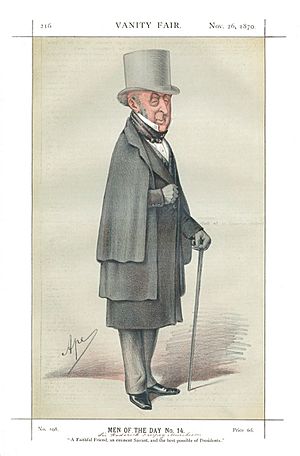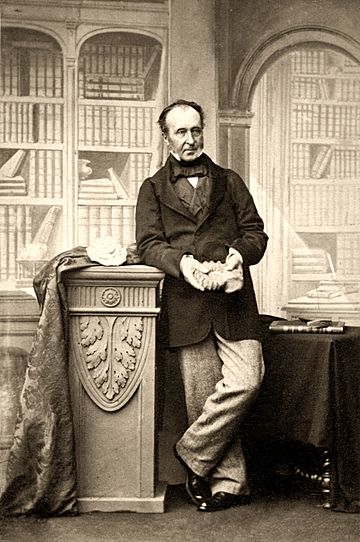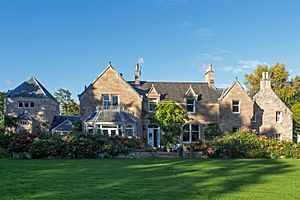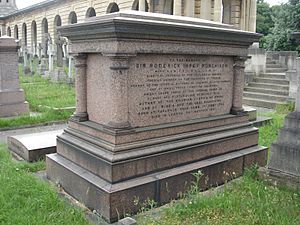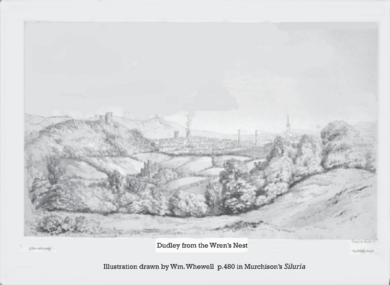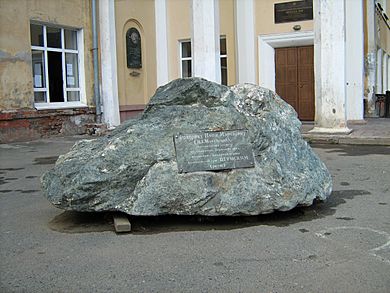Roderick Murchison facts for kids
Quick facts for kids
Roderick Murchison
|
|
|---|---|
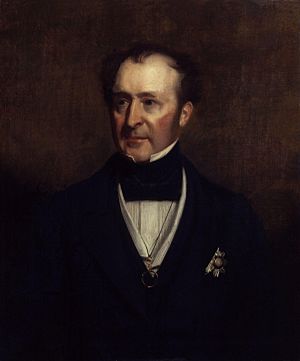
Sir Roderick Murchison
|
|
| Born | 19 February 1792 Tarradale House, Muir of Ord, Ross-shire, UK
|
| Died | 22 October 1871 (aged 79) London, UK
|
| Nationality | Scottish |
| Known for | Silurian system Devonian system Permian system |
| Spouse(s) | Charlotte Hugonin |
| Awards | Copley Medal (1849) Makdougall Brisbane Prize (1859) Wollaston Medal (1864) Founder's Medal (1871) |
| Scientific career | |
| Fields | Geology |
| Signature | |
Sir Roderick Impey Murchison (born February 19, 1792 – died October 22, 1871) was a famous Scottish geologist. A geologist is a scientist who studies the Earth's solid features, like rocks and mountains. He was in charge of the British Geological Survey from 1855 until he passed away.
Murchison is best known for finding and describing three major geological time periods. These are called the Silurian, Devonian, and Permian systems. A "system" in geology refers to a set of rock layers formed during a specific time period.
Contents
Early life and his start in geology
Roderick Murchison was born at Tarradale House in Muir of Ord, Scotland. His father died when Roderick was only four years old. He went to school at Durham and then trained for the army. In 1808, he joined the army in Portugal. He fought in battles like Roliça and Vimeiro. He also took part in the difficult retreat to Corunna.
After serving for eight years, Murchison left the army. He married Charlotte Hugonin in 1815. They spent two years traveling in Europe, especially in Italy. Later, they settled in Barnard Castle, England. There, Murchison met Sir Humphry Davy, a famous chemist. Davy encouraged Murchison to study science.
With his wife Charlotte's support, Murchison became very interested in geology. He joined the Geological Society of London. He quickly became a very active member. He worked with other important geologists like Charles Lyell and Charles Darwin.
Murchison and his wife explored the geology of southern England. They focused on rocks in Sussex, Hampshire, and Surrey. He wrote his first scientific paper about these rocks in 1825. He also explored volcanic areas in France and Italy with Lyell. Later, with Adam Sedgwick, he studied the complex geology of the Alps mountains. Their work on the Alps is still important today.
Murchison had different ideas about how life on Earth changed. He believed in "successive creation." This meant he thought new groups of living things were created over time. This was different from Charles Darwin's theory of evolution.
Discovering ancient rock systems
In 1831, Murchison went to the border between England and Wales. He wanted to see if the old greywacke rocks could be put into a clear order. This led him to create the Silurian system. For the first time, he grouped many rock formations together. These rocks had unique fossils, different from other rocks in England. His findings were published in his book, The Silurian System (1839).
After the Silurian system, Murchison helped establish the Devonian system. He worked on this in England and Germany. Soon after, he planned a big geology trip to Russia. He wanted to see if his rock classification system worked there too. He traveled with Édouard de Verneuil and Count Alexander von Keyserling. Together, they wrote a book about the geology of Russia and the Ural Mountains in 1845.
In 1846, Murchison was made a knight. He also led a meeting of the British Science Association. He spent many years working for the Royal Geographical Society. He was one of its founders in 1830. He served as its president several times.
Murchison also named the Permian system in 1841. He found these rocks during his explorations in Russia.
Murchison helped make British geology famous around the world. He saw his geological systems spreading globally as a way to show scientific power. He sometimes called his geological trips "invasions" or "conquests." People even called him the "King of Siluria."
Studying Scotland's geology
In the last ten years of his life, Murchison studied the Scottish Highlands. He thought he had found that huge masses of crystalline rocks, believed to be very old, were actually no older than the Silurian period. He thought this because he found limestone and quartzite beds with older fossils underneath them. This idea led to a big debate called the "Highlands Controversy."
Other geologists, like James Nicol, disagreed with Murchison. Later research by Charles Lapworth and others showed that the fossil-rich rocks were not in their original place. They had been moved by massive geological shifts. Older rocks had been pushed up and over younger ones.
In 1855, Murchison became the director-general of the British Geological Survey. He also directed the Royal School of Mines and the Geological Museum. He had many official duties, but he still found time for his research in the Highlands. He also updated his book Siluria several times. This book explained his Silurian system and new discoveries.
Later life and honors
In 1845, Murchison met some miners from Cornwall who were going to Australia. He thought there might be gold there and asked them to send him samples. They did, so Murchison knew about gold in Australia before it was widely discovered.
Murchison received many awards for his work. In 1863, he became a Knight Commander of the Bath (KCB). Three years later, he was made a baronet, which is a special title. The Royal Society gave him the Copley Medal. The Geological Society gave him the Wollaston Medal. Many foreign scientific groups also made him an honorary member.
Murchison also helped create a geology and mineralogy teaching position at the University of Edinburgh. In his will, he set up the Murchison Medal and a geological fund. These are still awarded every year by the Geological Society in London.
Roderick Murchison died in 1871. He is buried in Brompton Cemetery in London.
Legacy and memorials
The Murchison crater on the Moon is named after him. At least fifteen places on Earth are also named in his honor.
These places include:
- The Murchison Range and Murchison Sound in Greenland.
- Mount Murchison in Canada.
- Mount Murchison in Antarctica.
- The Murchison Falls in Uganda.
- The Murchison River in Western Australia. Two other rivers there, the Roderick River and the Impey River, are also named after him.
- The town of Murchison in New Zealand.
- Murchison Road in east London and Murchison Avenue in southeast London.
- Murchison Street in Scarborough, North Yorkshire.
A viewpoint called Murchison's View is named after him. It is in the Wren's Nest area of Dudley, England. From there, you can see much of Birmingham. Murchison's visits to the limestone hills of Dudley helped him understand the Silurian System. When he returned in 1849, 15,000 local people greeted him. They called him the "King of Siluria."
Memorials
A memorial tablet for Murchison was put up in front of School #9 in Perm, Russia, in 2005. This was because of his explorations there.
In 2009, a group called the Ural-Scottish Society built a memorial to Murchison. It is on the banks of the Chusovaya River in Russia.
There is also a special 'blue plaque' on his old home at 21 Galgate in Barnard Castle, England.
A made-up version of Murchison appears in the movie Ammonite (film). He is played by actor James McArdle.
Images for kids
See also
 In Spanish: Roderick Murchison para niños
In Spanish: Roderick Murchison para niños


